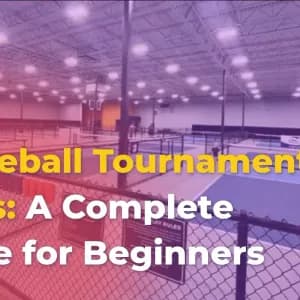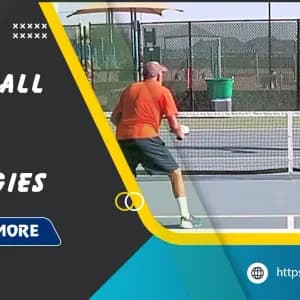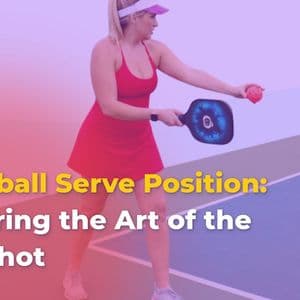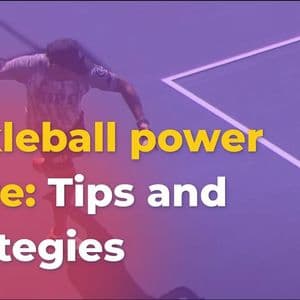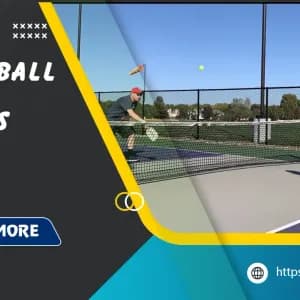Understanding the fundamentals
Before diving into the nuances of foot faults, it's essential to grasp the fundamental rules of pickleball and where these violations arise. Understanding the rules is akin to a painter knowing their canvas before creating a masterpiece. The game revolves around a few critical areas: the kitchen (or non-volley zone), the baseline, and the server’s position during play.
In pickleball, players must serve from behind the baseline and ensure that both feet remain behind this line until the ball has been struck. The kitchen adds an additional layer of complexity; players cannot step into this zone to play a volley unless the ball has first bounced. Understanding these rules creates a foundation for avoiding mistakes that could disrupt gameplay.
What is a pickleball foot fault?
Simply put, a foot fault occurs when a player steps on or over the baseline or sideline during a serve or while volleying. It is a violation that can lead to loss of points and ultimately undermine the integrity of the game. Defining this violation is crucial, as it brings clarity to what players must avoid.

When a player commits a foot fault, they not only face a penalty in a competitive environment but also a moment of sheer frustration. Picture an artist who spills paint on their canvas after making a mistake; similarly, a foot fault disrupts the player’s rhythm.
Why pickleball foot faults matter
Understanding foot faults is essential not just for individual performance but for fostering a sense of fair play. In competitive settings, adhering to the rules ensures that everyone has an equal opportunity to succeed. When players respect the boundaries defined by rules, such as those surrounding foot placement, they cultivate a positive environment that encourages healthy competition.
Moreover, foot faults can give a player a competitive edge if ignored, skirting the boundary of fairness. Hence, becoming attuned to these nuances underscores the importance of honesty and integrity in the sport.
Conquering service foot faults
Foot faults can be particularly detrimental when it comes to serving. The act of serving is the opening move in a game, akin to a movie’s opening scene that sets the tone for the entire tale. Any misstep can change the trajectory of the game, making understanding the serving rules paramount.
Service foot fault rules
In pickleball, the service rules outline that players must remain behind the baseline when striking the ball. If a player steps over the line before they make contact, it constitutes a foot fault. The sideline extensions also come into play; stepping across these lines during a serve can lead to significant penalties.

Think of service foot fault rules as the framework of a sturdy building if the foundation is not secure, the entire structure risks collapse. Mastering the rules is essential to building a solid game.
Common service foot fault mistakes
Many players fall into the trap of stepping over the line when serving due to nervousness or excitement. Improper foot placement can lead to an inadvertent foot fault, causing frustration and loss of momentum. Establishing a consistent serving routine can mitigate these common errors.
Maintaining focus on foot placement ensures players adhere to the baseline’s boundary, leading to a more fluid game. Players should visualize their foot positioning as they prepare to serve, just as an archer aligns their aim before releasing an arrow.
Drills to perfect your serve and avoid foot faults
Improvement comes through practice, and players must dedicate time to establish footwork techniques in serving. Here are some drills that can help:
- Baseline Awareness Drill: Stand behind the baseline and practice serving while thoughtfully monitoring your foot placement. Visualize remaining behind the line until you make contact with the ball.
- Shadow Serves: Perform practice serves while focusing solely on foot positioning. Imagine an opponent waiting to return your serve, creating mental pressure while fine-tuning your footwork.
- Balance Training: Incorporate exercises focused on balance and stability to improve overall footwork. This can include single-leg stands or agility ladder drills.
These drills not only enhance foot control but also build confidence, enabling players to serve without the distraction of potential faults.
Mastering the non-volley zone (kitchen)
The non-volley zone, commonly known as the kitchen, is another critical area where foot faults can manifest. Mastery of this zone can be the difference between winning and losing a competitive match, akin to understanding the nuances of a delicate dance.

Kitchen foot fault fundamentals
The kitchen has specific rules regarding volleying; players must be aware of their foot placement. As a reminder, stepping into the kitchen while volleying the ball results in a fault. The collisions of momentum and physicality, especially when players are eager to dominate points, can lead to these unintentional infractions.
Understanding the dimensions of the kitchen, along with its boundaries, is foundational for players aspiring to improve their game.
Types of kitchen foot faults
Missteps in the kitchen can take many forms. Here are a few types of kitchen foot faults to keep in mind:
- Stepping In: This occurs when a player steps into the kitchen before the ball has bounced.
- Momentum Violations: Players often lose track of their position when they advance toward the kitchen to volley; maintaining control of momentum is essential.
- Equipment Violations: Players must be cautious about their equipment slipping, which can inadvertently lead to violations.
Recognizing these potential pitfalls can help players refine their strategies in crucial moments.
The "elf toe": Close calls and avoiding kitchen errors
The concept of the "elf toe" refers to those moments of near misses when a player barely touches the kitchen line with their foot. This emphasizes the need for precision footwork and heightened court awareness.
A well-known example comes from player Thomas Wilson, who exemplifies how maintaining awareness of foot placement can minimize close calls. Refining one’s awareness of foot positioning is essential in avoiding costly kitchen errors.
Consequences of foot faults
Every action has consequences, and in the case of foot faults, the repercussions can ripple through the game. Understanding these impacts not only highlights the importance of avoiding faults but also educates players on the stakes involved.

The price of a foot fault
When a foot fault occurs, the player faces a loss of serve or a point loss, significantly altering the game’s momentum. These penalties can detract from a player's confidence and disrupt their flow. In a high-stakes match, even a fleeting moment of distraction can lead to game-shifting foot faults.
How foot faults disrupt game flow
Foot faults cause shifts in momentum that can have psychological impacts. Players sometimes get caught in a cycle of frustration and anxiety after committing a fault, negatively impacting their performance. This can lead to unintended errors in subsequent plays, creating a snowball effect detrimental to a player’s strategy and focus.
Calling foot faults: Etiquette and fair play
In pickleball, calling foot faults appropriately requires an understanding of both the rules and the spirit of the game. Maintaining respect and communication between players ensures a fair playing experience.
Calling foot faults in tournament play
In officiated matches, the referee’s role is pivotal in monitoring foot faults. Their presence provides a level of authority that maintains game integrity while ensuring all players adhere to the established rules. Competitors must remain aware and respectful, acknowledging calls made in good faith.
Calling foot faults in recreational games
In non-officiated games, honesty and respect become paramount. Players are responsible for calling foot faults on themselves or their opponents, fostering a spirit of cooperation. Open communication about potential violations can help resolve disputes amicably, keeping the spirit of friendly competition alive.
Tips for calling foot faults responsibly
To navigate the complexities of calling foot faults, players should:
- Maintain a clear view of the court, positioning themselves appropriately to witness potential violations.
- Call violations with certainty to avoid unnecessary disputes or heated arguments.
- Practice sportsmanship, acknowledging that everyone makes mistakes and fostering respect for opponents.
Advanced footwork techniques: Elevate your game
Mastering footwork can be a game-changer for pickleball players. By focusing on balance, agility, and positioning, players can enhance their overall performance on the court.
Developing balance and control on the court
Incorporating balance-focused drills, such as practicing on stability balls or using balance boards, can sharpen a player’s footwork awareness. These exercises promote core strength, essential for maintaining stability during rapid movements, thereby naturally heightening footwork finesse.
Quick steps and recovery: Gaining a footwork advantage
Players should focus on agility training to improve quick steps and recovery movements. Implementing reaction time exercises, such as partner drills where players respond to verbal cues, can build muscle memory and lead to faster reactions on the court.
Anticipating your opponent's shots
Anticipation is a key factor in pickleball. By reading the opponent’s body language and shot preparation, players can position themselves strategically. Effective strategic positioning minimizes unnecessary movement and enhances offensive capabilities, allowing players to capitalize on their opponent's weaknesses.
Mental toughness: Conquering foot fault pressure
Just as physical skills matter, mental strength is vital in overcoming the psychological pressure stemming from foot faults. A calm, focused mind can drastically reduce errors and improve overall performance.
Maintaining focus and awareness
Practicing mental discipline is essential for avoiding distractions that could lead to faults. Engaging in meditation or mindfulness exercises can help players remain present during gameplay, enhancing their overall tactical awareness.
The power of a pre-shot routine
Establishing a consistent pre-shot routine can build confidence and reduce foot faults. By incorporating mental visualization strategies, players can prepare themselves for the nuances of the serve, keeping their footwork in check.
Managing pressure and anxiety
Fostering relaxation techniques, such as controlled breathing and positive self-talk, can help players reduce anxiety, especially in high-pressure situations. Feeling confident and composed allows players to better focus on foot placement, ensuring they respect the boundaries of the court.
Gear up for success: Footwear and equipment
The right footwear and equipment can drastically impact performance, particularly concerning foot faults and overall court mobility.
The importance of proper pickleball shoes
Investing in quality pickleball shoes provides players with enhanced grip and lateral support. A comfortable shoe can allow for quicker, more agile movements, reducing the likelihood of foot placement issues that result in faults.
Insoles: Enhancing support and stability
Other gear to consider
Don't forget about apparel, socks, and even hydration equipment. Comfort plays a significant role in performance; ensuring players are equipped with the right gear can help them maintain focus and confidence, ultimately leading to better adherence to court rules.
Learning from mistakes: The path to improvement
Self-analysis and reflective practice are crucial components for any athlete looking to improve. By understanding the recurring nature of foot faults, players can develop a personal roadmap to success.
Analyzing your foot faults
Players should take the time to analyze their game, focusing on identifying patterns related to foot faults. Video reviews can unveil common tendencies and potential areas for improvement.
The value of feedback
Seeking input from coaches, experienced players, or partners fosters continuous learning. Constructive feedback serves as a guiding light for players eager to refine their skills and make meaningful adjustments.
Continuous improvement: Make every point count
A growth mindset is pivotal in embracing challenges and learning from mistakes. By treating each point as an opportunity for development, players can foster resilience and elevate their overall game.
Additional resources for pickleball players
Consider exploring instructional videos, online tutorials, and local clubs’ training sessions to further broaden your knowledge and expertise. Continuous education on pickleball rules and strategies enables players to evolve and embrace the sport fully.
Clarifying specific rule interpretations can help players understand nuances that often lead to confusion. Engaging with local clubs or the USA Pickleball Association often provides valuable resources.
In conclusion, mastering footwork and understanding foot faults are integral to becoming a successful pickleball player. By focusing on the fundamental rules, enhancing foot placement, and learning from mistakes, players can cultivate a game characterized by fairness and skill. The beauty of pickleball lies not just in scoring points, but in embracing the journey of growth and improvement on the court. Understanding these nuances strengthens players’ capabilities while enriching the spirit of the game itself.


